Business
Top 10 Most Website Builders That Doesn’t Suck
Published
5 years agoon
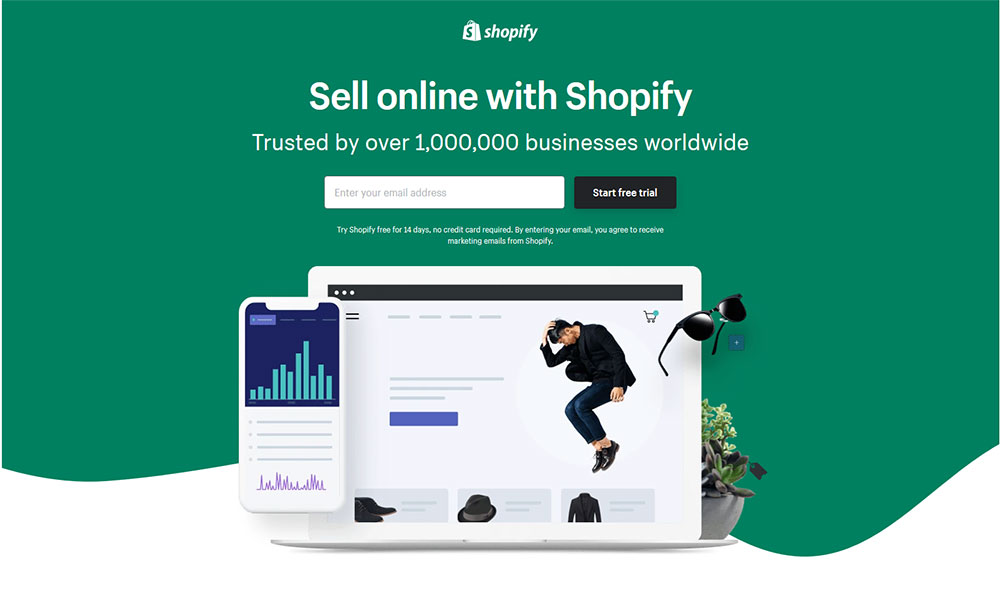
Create your own pages with the best website builders. There are hundreds to choose from but we’ve already selected the top 10 for you.
Years ago, only professionals that know how to use codes can create an effective website. It’s a daunting skill that most of us would rather outsource. But as always, technology found a way to make website building easier for an average internet user. You don’t have to learn codes (although it’s still useful in some cases). And you can create your website in just a few minutes! All thanks to website builders.
Best Website Builders 2020
Before creating this list, we asked our team of website developers and designers to assess each website builder. Likewise, non-website builders from our group were also tasked to create simple pages. This approach allowed us to gauge each website builder based on its features and ease-of-use.
1. Webflow
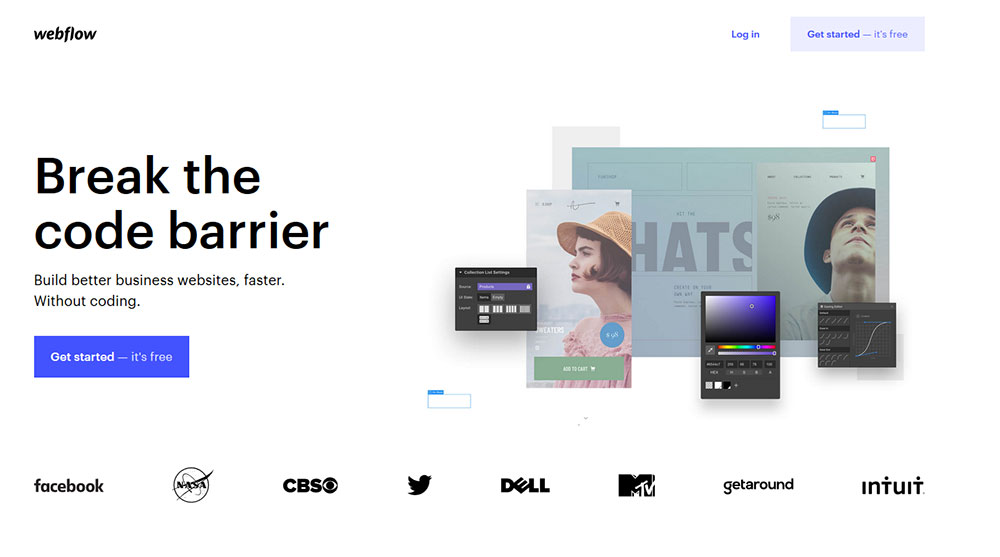
Webflow is a website builder that’s perfect for both amateurs and professionals. It allows you to create websites without using codes, yet you can still customize it depending on your needs. You will also find their templates useful so you don’t have to start your web design from scratch.
When we tested it out, our group didn’t have problems onboarding the platform. The instructions are straightforward and you can build right then and there. But just in case you need some help, their tutorial is tailored-fit for first-timers.
Webflow has this ‘Box Model’. It’s a process where you think of your elements as boxes. Generally, you have your image boxes, text boxes, and button boxes which you can overlay to get that web design you want.
If there is one improvement that we are looking forward to, that would be their personal support. Yes, tutorials are available, but of course, there are questions that are best answered by an actual support team. Webflow’s pricing starts at $35 per month.
2. Carrd
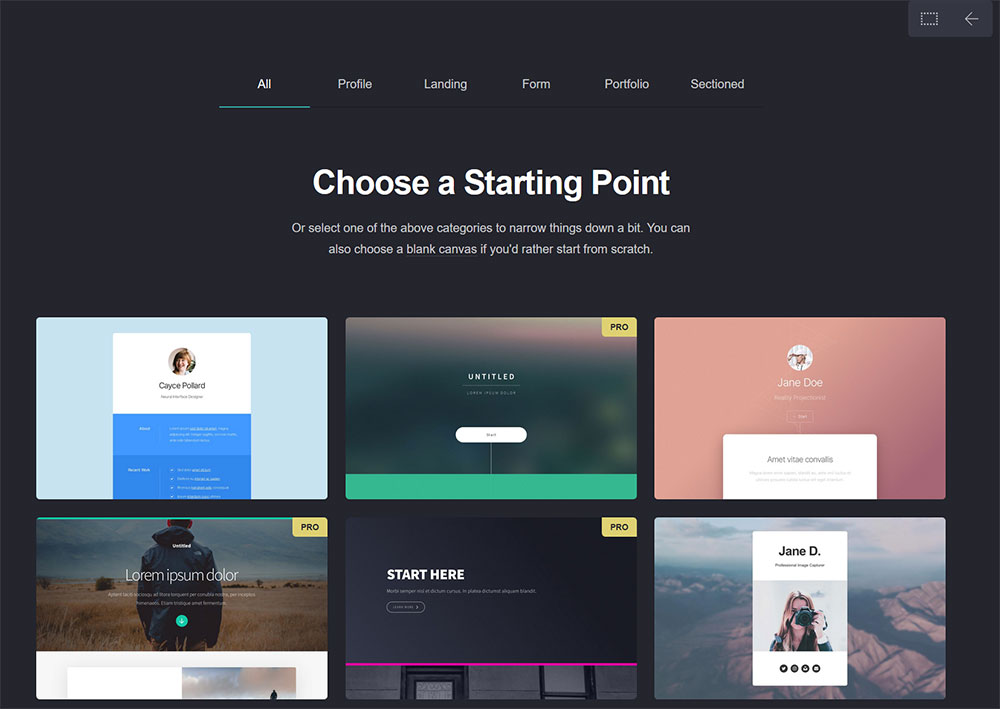
Carrd might be an underdog in the world of website builders, but it sure does a great job. Aside from being user-friendly, the web pages you create from it will load fast. That’s a huge point for them. As for the templates, these are nothing short of amazing. Just some tweaks and you’re all set to go.
We also timed our test, from signing in until we created a live page. Surprisingly, it took us less than an hour.
However, this might not sit well for pros and for e-commerce content. Nevertheless, for a price of $19 per year for their Pro Lite package, this has got to be the cheapest in the market today. Yes, the cost is per year and it isn’t a typo.
3. Wix

Wix is probably one of the most popular website builders in the list – thanks to their aggressive marketing. But is Wix worth the rave?
It actually is. To date, there are more than 180M users around the globe and that’s a testimony that Wix works. It’s easy to use, yet customizable. In fact, your professional web designers will enjoy it too.
Wix design options are commendable as well. They have a huge library where you can find awesome templates that can instantly give your website that professional look.
Lastly, they have a reliable support team that can answer your concerns, the soonest possible time. Wix has several plans to choose from and starts at $24.50 per month.
4. Squarespace

Included in our best website builders list is Squarespace. This is the right platform if your priority is the visual appearance. Their templates are carefully designed. The main challenge is actually choosing one (because everything seems to be perfect).
If this is your first time to design a website, Squarespace will not intimidate you. Just drag and drop elements, and you are all set. It doesn’t matter if you are building a website for your online store, a non-profit organization, travel, or photography blog. This website builder will surely have something for you.
There is no blank canvas though. But that’s not enough for us to dislike it. You can start with their Personal plan for only $12 per month.
5. Duda
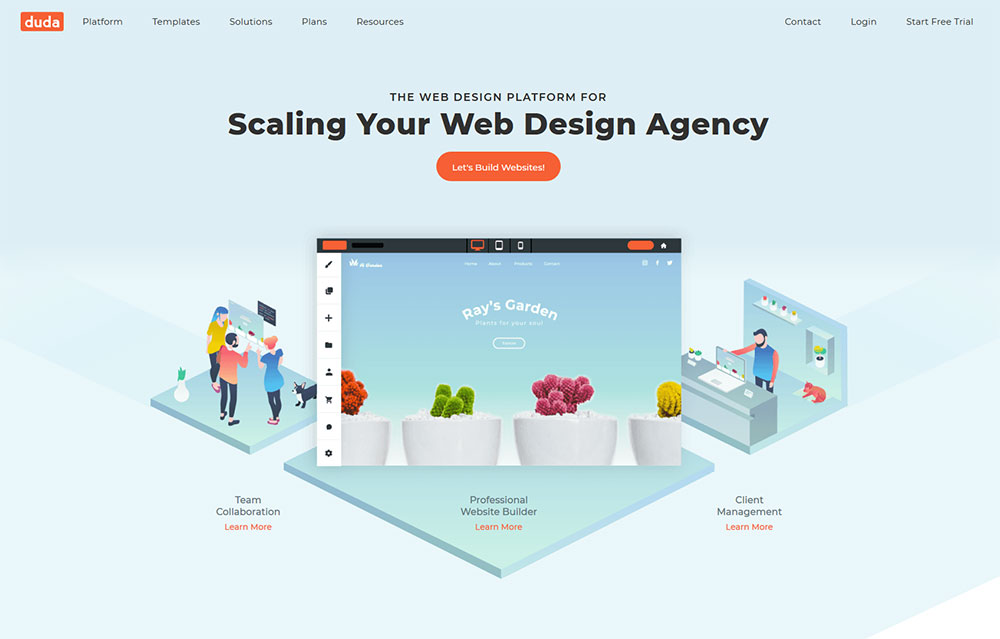
Duda has everything you need for a good website builder plus more. Apart from being user-friendly and having cool templates, it also has a feature where you and your team can easily collaborate. The platform allows you to leave comments on the design and this makes the entire process faster.
One of the downsides of choosing Duda is that their plans are quite costly. Getting their least expensive package for $14 per month is too restricted in our opinion.
6. GoDaddy
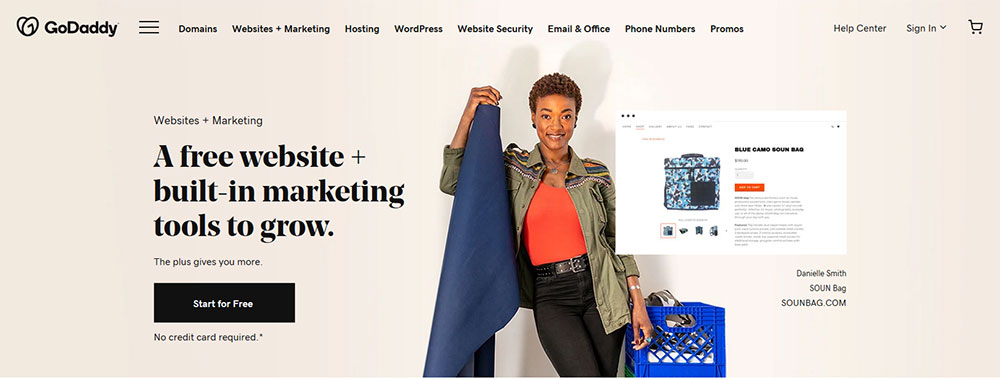
Another website builder that has taken the world by storm is GoDaddy. We’ve already used this platform a couple of years ago, and we have to say that there were a lot of improvements. The designs are now modern, and there are SEO and marketing features that are obviously essential for your website’s success.
Quite frankly, most website builders will promise you the same thing – that you can build a website right away. The same is also true with GoDaddy. But what sets it apart is its customer service. They have 24/7 support through phone, email, and ticketing systems. So basically, it doesn’t matter where you are. If ever you have trouble with your website, just reach out to them and get answers fast. However, if you are looking for a website builder that allows more creative and design freedom, this might not be the best choice.
You can get a package for $10 a month.
7. Ucraft
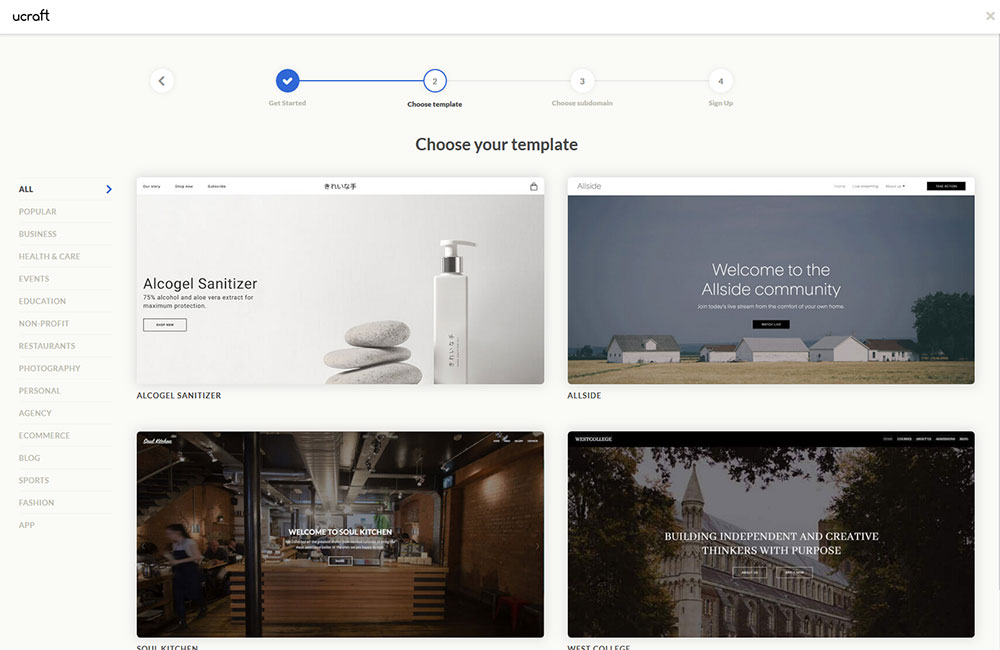
Ucraft isn’t one of the biggest players in the market, but it still deserves to be on our list of the best website builders. You can create your blog, business website, or e-commerce page from this platform. As for the ease-of-use, we have to say that it can be a bit challenging as you cannot move the ‘ready-made blocks’ around your template. It’s as if there is a pre-determined space allotted for these.
What we enjoyed though is the free logo maker. This is ideal for a startup company that has yet to create their brand identity. Their Pro package is $10 per month.
8. Shopify

If you are building an online store, then we could not recommend anything better than Shopify. And right now, it powers more than 800,000 businesses around the world. They have an amazing inventory, tracking, and shipping tools.
This is ideal even if you don’t have an idea about e-commerce design. Everything you need is here. They even have their own payment gateway. The interface is simple and clear so you can start building your online empire whenever you want to.
The Basic Shopify Plan is $29 per month. But as you grow your business, we encourage you to get their higher tiered packages.
9. Weebly
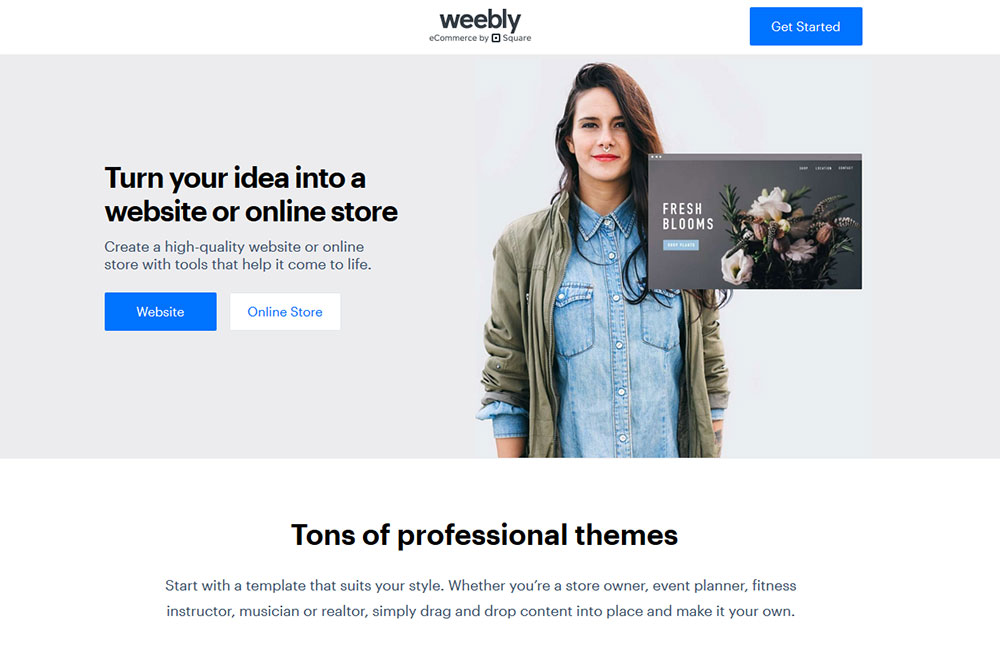
We cannot really say that Weebly is the best website builder. In fact, back in the days, you will find reviews mocking their templates for being below average. They took it to the core and made changes. And we are happy to say, it’s all good now. If they continue making improvements, we will not be surprised if it will get a bigger portion of the market soon.
As of the moment, we can recommend it for small businesses only. You can add advanced site tools if you want. It’s versatile enough not just for beginners but also for pros in web designing.
Their Professional package starts at $12 if you subscribe for one year.
10. Webnode
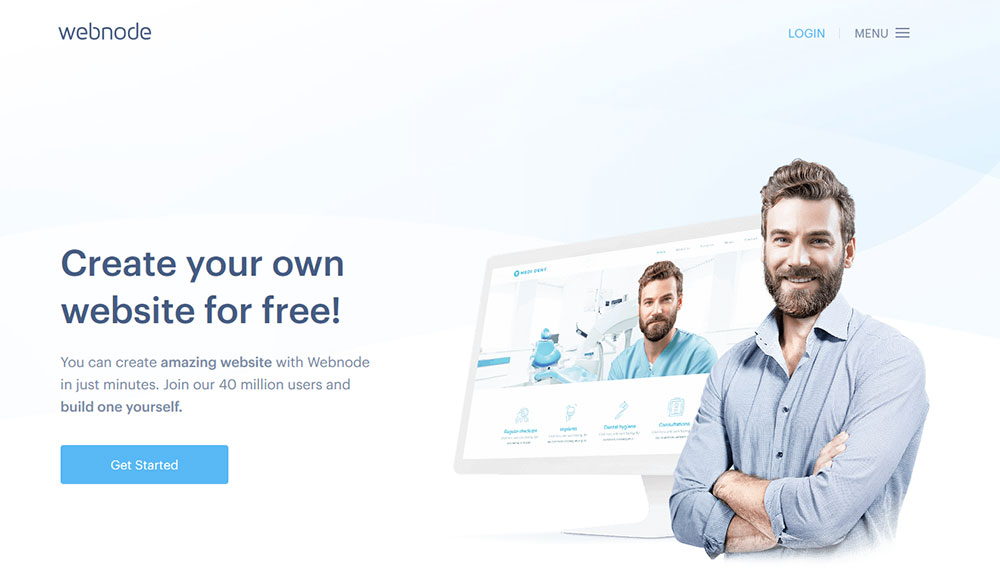
Lastly, we have Webnode, a website builder that supports more than 20 languages. This means you can create a multilingual website. That’s precisely the reason they now have more than 40M registered users. And let’s not forget, it is also great for SEO.
Just recently, they made improvements to their editor and shopping cart features. Nothing’s wrong with the old ones. But seeing that they are proactive in making changes, that’s already a good sign on how they will handle future requirements. As of the moment, this is not the ideal choice for e-commerce websites.
If you want a professional and bilingual website, you can choose their Standard package for only $11.95 per month.
Conclusion
Having a website now brings added value to your business and organization. There’s no reason for you not to have one given the best website builders out there. A quick reminder though. Don’t forget to look at the package’s inclusions. The cheapest one might be too restricted and it would be more practical to get the higher plans. So take your time in understanding the features and then start building your website.
You may like
Business
Top 10 Best Places to Buy a Mid Century Modern Office Chair
Published
2 days agoon
July 4, 2025
What was once old is new again: mid century modern is back in style. From architecture to furniture, the postwar look is in, and the hype extends all the way to office chairs.
Do you need a mid century modern office chair in your life? If so, there’s plenty to choose from. Your office chair should be tailored to your style, whether you like luxury, utility, or something in between.
That’s why we’ve put together our 10 favorite places to find your ideal mid century modern office chair.
What is mid century modern design?
After World War II, spirits were high in the US, and new technology was taking the country by storm. Mid century modern refers to the design concepts that came about during this time.
As opposed to the frilly, ornate designs of classical furnishings, mid century modern designs are angular, material, and functional. Wood is a common design element, especially teak. Mid century modern furniture may also have materials like glass, vinyl, and metal. Designs are simple and geometric, with bold accent colors to make them pop.
The mid century modern aesthetic never really went away, but it’s made a noted comeback in recent years. Some have chalked it up to Boomer and Gen X nostalgia, others point to mid-century-set shows like Mad Men and The Marvelous Mrs. Maisel.
Why should I buy a mid century modern office chair?
Mid century modern is the perfect fusion of style and utility. If you want to cultivate an office space that commands respect without being ostentatious, mid century modern is the style for you.
When it comes to office chairs, an MCM one is often made with sturdy wood and vinyl. They combine the ergonomics of a modern office chair with old-fashioned grace.
If you’re concerned with utility and utility only, a more bog-standard office chair may suit you. But a mid century modern office chair is great for someone who wants to wow colleagues with a mature, thoughtful business space.
Where can I get a mid century modern office chair?
1) Wayfair
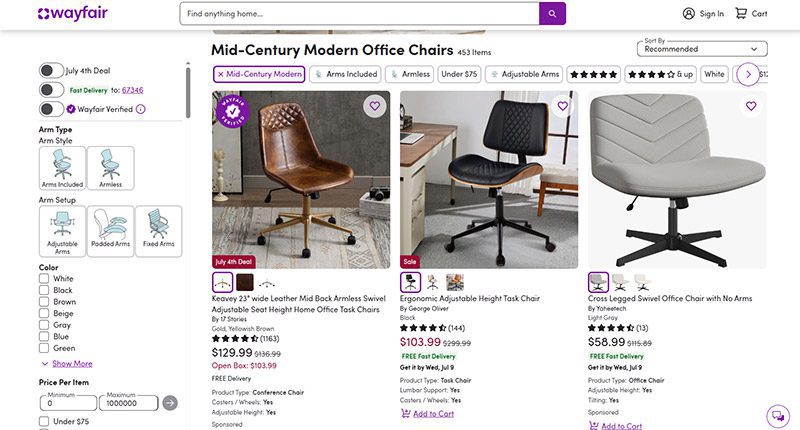
When it comes to furniture, Wayfair offers the best of both worlds. Their goods, including their mid century modern office chairs, are stylish and affordable. You can get a sturdy task chair for less than $100 or a more distinguished seat for less than $350.
MCM office chair examples: Dovray ($126), Bradford ($139), Lithonia ($133)
2) France & Son
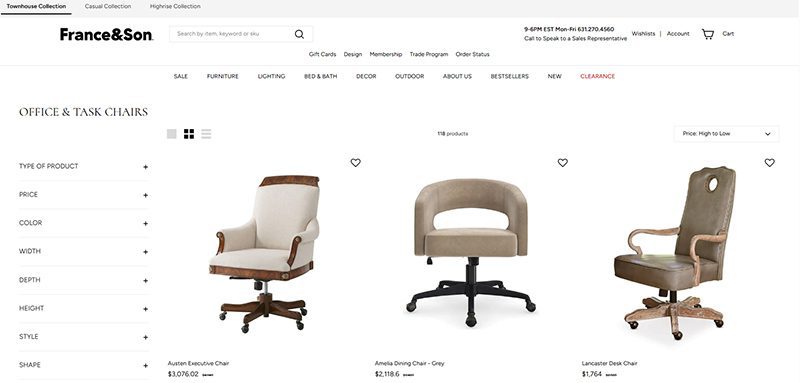
Wayfair’s chairs are affordable, but France & Son is the perfect option for luxury shoppers. Their mid century modern office chairs are robust and sleekly designed. If you dress to impress and enjoy the finer things in life, these are the chairs for you.
MCM office chair example: Brooks ($695)
3) Houzz

Started as a community for people to share home decor tips, Houzz has become a great ecommerce platform for finding stylish furniture. They’re more known for home decor than desk chairs, but they have plenty of great, affordable finds if you know where to look.
MCM office chair examples: Arvilla ($173), Rathburn ($259)
4) Laura Davidson
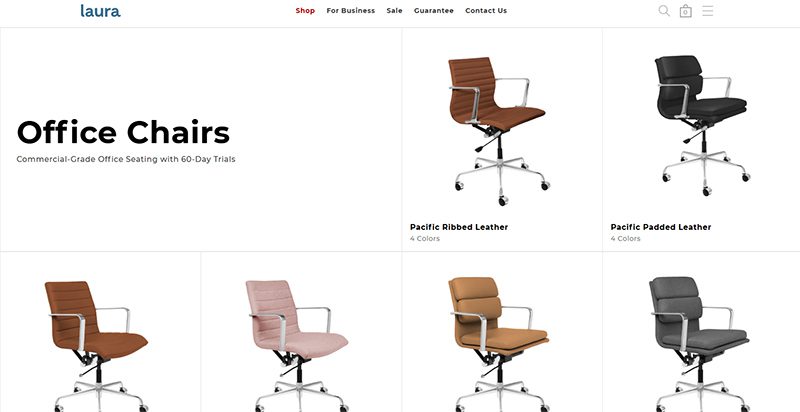
The Laura Davidson collection offers a fairly limited selection of classic office furniture. Still, there’s a reason they’re trusted by big-wigs like Apple, Disney, and Salesforce. Their chairs are sturdy and beautifully designed, reimagining classic Eames and Knoll designs.
MCM office chair examples: Rockefeller ($275), SOHO II Soft Pad ($450)
5) Icons of Manhattan
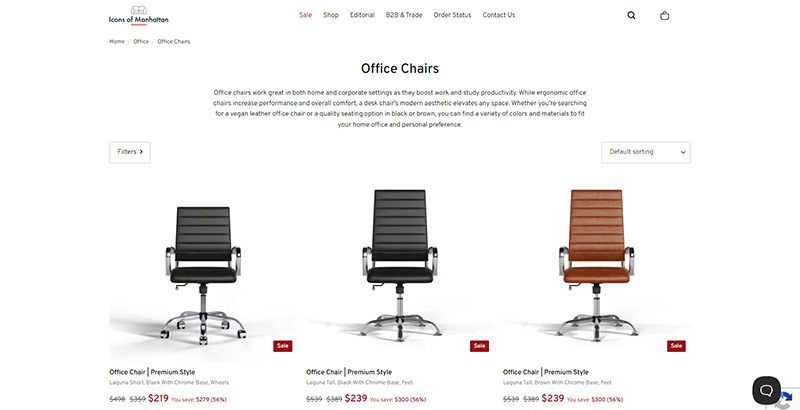
Icons of Manhattan has a simple philosophy: do one thing, and do it right. Their office chairs are handcrafted from premium materials and tailored to a mid-century modern style. If you want that Mad Men energy in your office (hopefully with a lot less angst), these are the chairs for you.
MCM office chair example: Ribbed Medium ($219)
6) Amazon
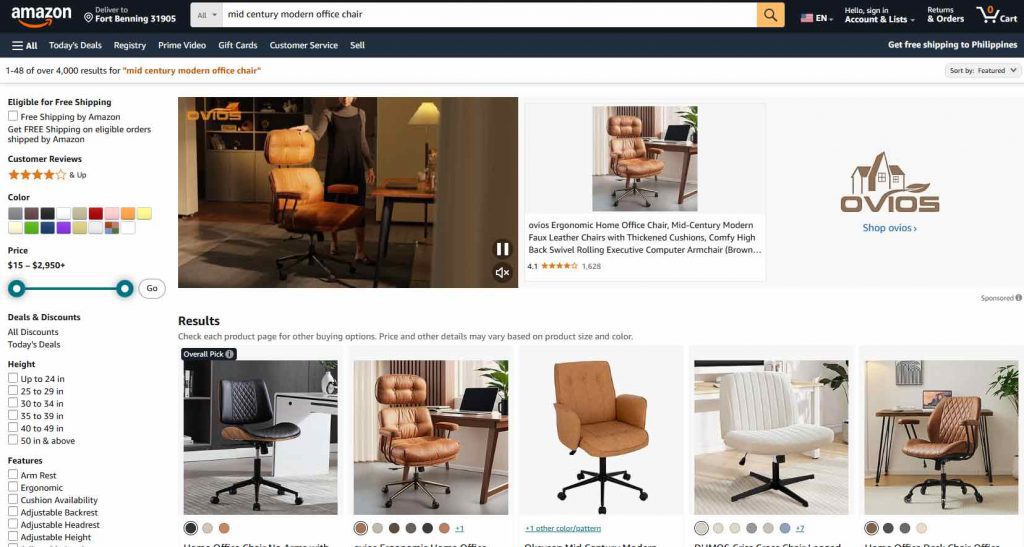
Yes, the internet’s premier shopping destination has a robust collection of mid century modern office chairs. Like with most products, their selection of seats is vast and can be hit or miss. Still, they’ve got stunning chairs available for any style, whether you care about comfort, class, or ergonomics.
MCM office chair examples: IDS Home Modern ($219), Art Leon MCM Swivel ($139)
7) AllModern
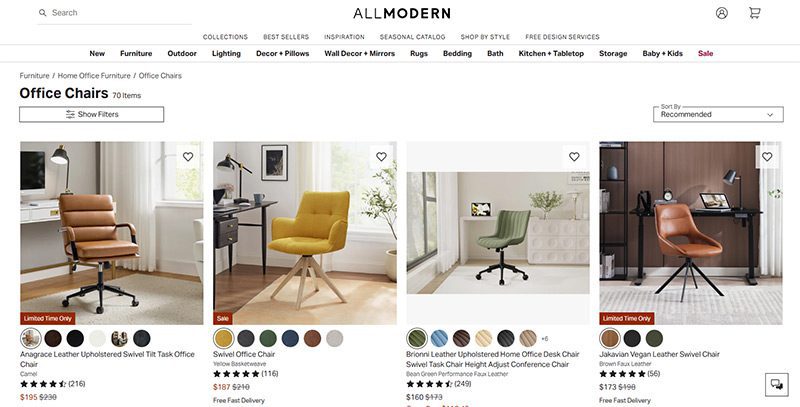
AllModern’s collection of desk chairs and other furniture truly embodies the mid century modern spirit. Their work is tight, angular, and functional above all. They’re part of the Wayfair family and they traffic in a number of modern styles, but their sleek chairs are perfect for any mid century modern space.
MCM office chair examples: Frederick ($229), Kealey ($349)
8) Overstock
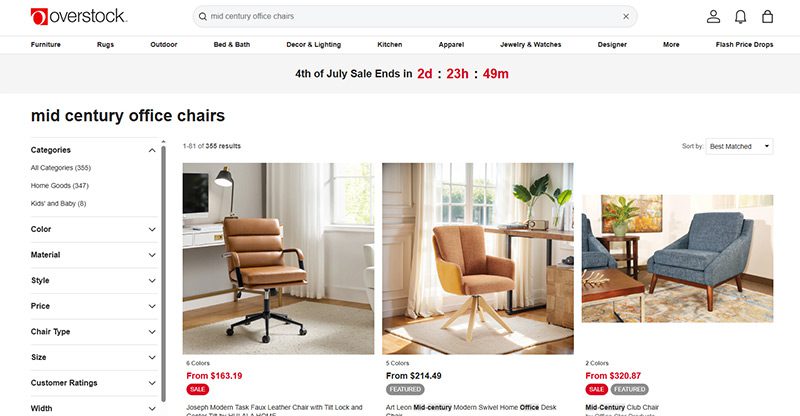
Overstock is known as a one-stop shop for quality home goods at sub-wholesale prices. If you want a spiffy mid century modern office chair that won’t break the bank, they’re the first place to look. While they’re somewhat less reliable than the more upscale platforms on this list, their selection is massive.
MCM office chair example: Joseph Modern ($163)
9) Walmart
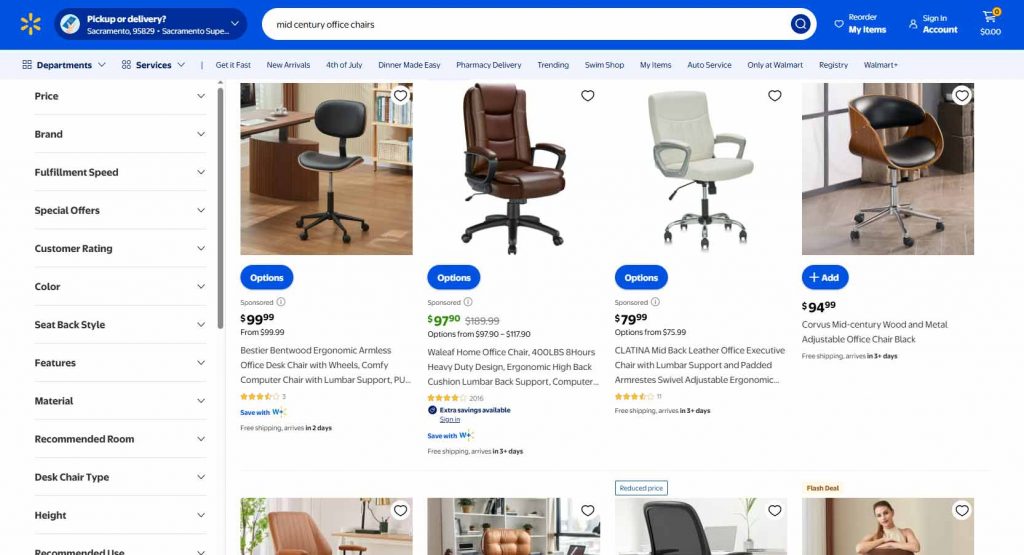
Hayneedle’s selection of mid-century modern office chairs falls somewhere between the minimal Laura Davidson and the endless Amazon catalog. Their array of mid-century designs is affordable and versatile, with chairs that match almost any style. While they may be part of the Walmart family, these chairs are anything but second-rate.
MCM office chair example: Waleaf ($97)
10) Target

Why splurge when you can save? As usual, Target is a hidden gem, offering a sturdy selection of mid century modern office chairs for some of the cheapest prices out there. Many of the chairs they offer are from the same designers as these other stores—Christopher Knight, LumiSource, Armen Living, etc.—at reduced prices.
MCM office chair example: Lombardi ($136)

A quality payroll service is one of the most invaluable tools any entrepreneur can have. Whether you’re a small business owner or an HR manager, paying your employees on time is crucial. This makes choosing a service even more weighty, after all, it is a heavy administrative burden. The good thing is, you can outsource this duty to an online payroll processor.
According to statistics, 49% of workers begin a new job search after just two paycheck errors, and with 65% of workers living paycheck to paycheck, it’s more important than ever to ensure an efficient, effective payroll process.
These services can save you precious time and mitigate potential issues. To make it easy for you to choose, we listed the best online payroll services for 2025.
Top 5 Online Payroll Services
Gusto
Gusto is a great option for both new and experienced payroll administrators, boasting an incredibly clean user interface and a first-rate payroll setup. Gusto lets you manage your employee’s time off (vacation and sick pay), company health insurance, and worker’s comp. Gusto offers excellent mobile access, too. This allows employees to manage aspects of their Gusto profiles, view payday insights, and access Gusto Wallet financial tools.
Gusto offers four tiers of membership, the most affordable of which is the Contractor’s Only plan, which offers unlimited U.S.-based and global contractor payments, supporting more than 100 countries, plus 1099 creation and filing at a rate of $6 per person per month with no base price.
The other three are Simple, Plus, and Premium. Here’s a deeper look into each plan:
Simple
Price:
$40/mo + $6/mo per person
Plan details:
- Full-service single-state payroll including W-2s and 1099s
- Employee profiles and self-service
- Basic hiring and onboarding tools
- Gusto-brokered health insurance administration
- Employee financial benefits
- Payroll and time-off reports
- Custom admin permissions
- Integrations for accounting, time tracking, expense management, and more
Plus
Price:
$80/mo + $12/mo per person
Plan details:
(All Simple plan features +)
- Full-service multi-state payroll including W-2s and 1099s
- Next-day direct deposit
- Advanced hiring and onboarding tools
- PTO management and policies
- Time tracking and project tracking
- Workforce costing and custom reports
- Team management tools
- Full support
Premium
Price:
Bespoke pricing, reach out for a personalized quote
Plan details:
(All Plus plan features +)
- HR Resource Center
- Compliance alerts
- Access to certified HR experts
- Full-service payroll migration and account setup
- Health insurance broker integration
- R&D tax credit discount
- Waived fees and exclusive pricing
- Performance reviews
- Employee surveys and insights
- Dedicated support
QuickBooks Online Payroll
Founded in 1983, Intuit is a California-based financial software company. Since its inception, Intuit has developed into one of the best-known providers of accounting software. Their online payroll service, QuickBooks, includes the essential features you need to run payroll.
QuickBooks offers three tiers of membership. The least expensive membership covers basic accounting features, such as invoices. For more features, check out the Essentials and Plus memberships. Each plan’s features are as follows:
QuickBooks Simple Start (2025)
- Price: $38/month for 1 user
- Best for: Freelancers and small teams with basic payroll needs
Features:
- Automated bookkeeping
- 5 free ACH bank transfers/mo for bills
QuickBooks Essentials (2025)
- Price: $75/month for 3 users
- Best for: Small businesses needing deeper financial tracking
Features:
- Includes all Simple Start features, plus:
- Recurring invoices
QuickBooks Plus (2025)
- Price: $115/month for 5 users
- Best for: Growing businesses with HR and compliance needs
Features:
- Includes all Essentials features, plus:
- AI-powered profit & loss insights
- Anomaly detection and resolution
- Budgeting
QuickBooks Advanced (2025)
- Price: $275/month for 25 users
- Best for: Established businesses with HR and compliance needs
Features:
- Includes all Plus features, plus:
- Custom user management and permissions
- Custom report builder
- Data sync with Excel
- Revenue recognition
- Forecasting
OnPay
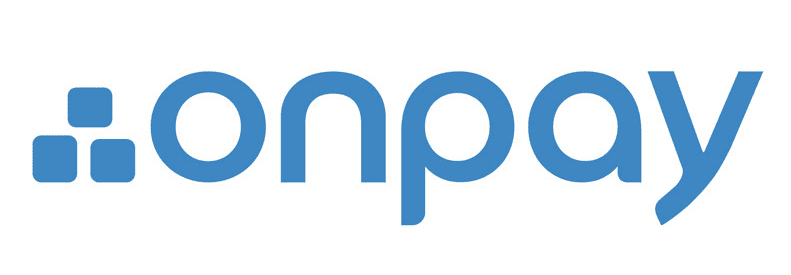
OnPay is a cloud-based full-service payroll processing system capable of running payroll according to a preset schedule, automatically disbursing wages, and calculating and withholding taxes.
OnPay can sync up with several other software your team is already using, making it easy to integrate the service into your team’s system. Another benefit of OnPays model is the simple, transparent pricing structure. No tiers; just one base rate.
Pricing:
$49/mo + $6/mo per employee
SurePayroll

SurePayroll’s award-winning service supports W-2 employees and 1099 contractors. Additionally, it handles 401(k) deductions and manages flexible spending accounts (FSA) and health savings accounts (HSA).
SurePayroll also offers a mobile app— available on both Apple and Android devices.
SurePayroll offers live support through its United States-based support team through chat, email, or phone.
Small Business Payroll
- Price: No Tax Filing: $20/month + $4 per employee, Full Service: $29/month + $7 per employee
- Best for: Small businesses and startups
Features:
- We file and deposit your federal and state taxes!
- Run payroll in 3 simple steps
- Schedule payroll to run automatically
- Unlimited payroll runs and free 2-day direct deposit
- Reports and pay stubs are available online 24/7
- Supports W-2 employees and 1099 contractors
Nanny & Household Payroll
- Price: Full-Service Household, $39/month, includes 1 employee, $10 per additional employee
Best for: Homeowners
Features:
- Signature-ready Schedule H
- We file & deposit your federal and state taxes!
- Run payroll in 3 simple steps
- Schedule payroll to run automatically
- Unlimited payroll runs and free 2-day direct deposit
- Reports & paystubs available online 24/7
- Supports W-2 employees & 1099 contractors
Be sure to choose a payroll service that works for your business, and provides you with the peace of mind that comes with a reliable bookkeeping system. Your employees will thank you.

Merck is currently in talks to acquire Seagen, a biotech company. The Wall Street Journal reports that the transaction is valued at $40 billion. And what happens if Merck acquires Seagen, and how would this acquisition benefit cancer research and treatment? Read more about the Merck Seagen buyout here.
Merck Seagen Buyout
Merck and Seagen are still deciding on their share prices. So far, talks have yet to reach an agreement on $200 per share. Both companies want to settle and finalize their deals before Merck announces its quarterly earnings on July 28. At the time of writing, Seagen’s stock was at $176.19.
With an estimated market value of $235 billion, Merck is looking to expand its presence in the cancer treatment space. The Merck Seagen Buyout could play a major role in that strategy. Since Seagen specializes in targeted cancer therapies, the acquisition would give Merck access to a broader range of oncology products.
Shareholder reactions to the new deal are overwhelmingly positive, and the stocks have been up since talks about the deal have been made public.
But this is not the first time that Merck and Seagen have made the news. Back in 2020, they collaborated because of cancer treatments. Seagen has a drug conjugate (ladiratuzumab vedotin) which would be used in conjunction with Merck’s Keytruda.
Merck reveals that Keytruda is its highest-selling product. It’s immunotherapy for cancer.
And this deal could help Merck offset the possibility of reduced sales because it will lose patent protection in 2028.
As promising as this deal is, there could be scrutiny from antitrust officials since there might be a litigation case from the Federal Trade Commission or Justice Department.
The Seagen buyout isn’t the only deal Merck has made recently. They’ve been busy closing another deal, but with Orion too.
Seagen
As a cancer biotech company, Seagen has therapies to ensure that patients benefit from the treatment and reduce any adverse side effects. Their treatments involve the therapy attacking tumors with toxins.
Merck partnering with Seagen isn’t a bad idea considering that Seagen made $1.4 billion in sales in 2021, most of it coming from Adcetris and Padcev (a treatment for urothelial cancers).
Merck-Orion Deal
In the middle of the Merck Seagen Buyout, Merck has recently partnered with Orion for the ODM-208 and other drugs. These drugs are related to the production of steroids. Orion found how it can combat hormone-dependent cancers and further developed this inhibitor.
Their deal includes that they should develop ODM-208 and promote it to the public together. And Orion will receive a $290 million payment from Merck.
Although they’re co-developing and marketing the new inhibitor, Orion will oversee the manufacturing side.
Co-developing the ODM-208 can help Merck with its current research and treatments for prostate cancer. President and CEO of Orion, Timo Lappalainen, says that this partnership will benefit Merck’s goals of treating cancer worldwide.
Other Ventures: Merck’s Role in the Pandemic
You may have heard about COVID-19 pills, which are a form of treatment for those diagnosed with mild to moderate COVID-19. Merck introduced an antiviral COVID-19 pill to the public. The name: Molnupiravir.
The COVID-19 pill is not a replacement for a vaccination. Instead, it stops the replication of the COVID-19 genetic code and keeps the patient out of the hospital. Not yet FDA-approved, Molnupiravir has been authorized for emergency use since December 23, 2021.
And for other stories, read more here at Owner’s Mag!

Top 12 Uses for The Metaverse That Will Change Your Life

Top 10 Best Places to Buy a Mid Century Modern Office Chair

The Best Online Payroll Services [Updated for 2025]

Top 10 Small Business Organization Tools for 2025

8 Best Equipment for YouTube Every Content Creator Needs

Merck Seagen Buyout: What to Know About the Deal

The Rise and Fall of Juul: Once a Silicon Valley Darling, Now Banned by FDA

What’s the Deal With Elomir? Is Axis Klarity a Scam?

Why Having an Advisory Board Could Make or Break Your Startup

Top 10 Best Places to Buy a Mid Century Modern Office Chair

Loom Review: Features, Use Cases, and How It Stacks Up Against Zoom

8 Best Equipment for YouTube Every Content Creator Needs

The Rise and Fall of Juul: Once a Silicon Valley Darling, Now Banned by FDA

The Best Ways to Recession Proof Your Business
Trending
- Business2 days ago
Top 10 Best Places to Buy a Mid Century Modern Office Chair
- Technology3 days ago
8 Best Equipment for YouTube Every Content Creator Needs
- Technology3 days ago
Top 10 Small Business Organization Tools for 2025
- Technology1 day ago
Top 12 Uses for The Metaverse That Will Change Your Life
- Business2 days ago
The Best Online Payroll Services [Updated for 2025]





